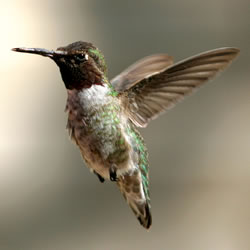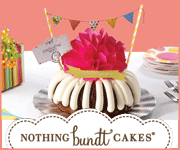EAT, DRINK & PLAY - ENTERTAINMENT
Now Entering Hummingbird Season
Hundreds Flock to Valencia Home
October, 2006 - Issue #24
 |
But there were a few clues.
That first feeder - the same no-frills, 16-ounce feeder you'd find at Target or Wal-Mart - emptied fast, suspiciously fast.
"I was sure it had a leak," says Duus. "I just couldn't believe it would empty that fast."
But this was no leak, not literally, anyway.
But it was the first crack in the dam, so-to-speak. From there, Duus' diligence, combined with factors such as weather patterns and the migratory patterns of certain species of hummingbird, combined to turn the Duus backyard into ground zero for the colorful and feisty little creatures.
During hummingbird season, which peaks August through October in this valley, the Duus home attracts hundreds of hummingbirds each day. While the rest of the valley is returning to school and picking pumpkins, Duus is going through a gallon of hummingbird nectar a day. Her yard becomes an ornithological airport, with dozens of hummingbirds darting from feeder to perch to flower to tree.
"The feeders kept emptying, so I'd put up another, then another," says Duus, who lives with her husband, Don, just over the ridge from Newhall Ranch Road in Valencia. "I didn't plan it. They just came."
A mathematical formula, based on the amount of nectar consumed per hour and the eating habits of hummingbirds, puts the Duus' bird population at about 500 different birds per day.
"It's like staring into a fishbowl," says Duus. "I love to sit in the backyard and just watch them. It's very relaxing."
According to Duus, three, and perhaps four different species of hummingbird call her backyard home. The Anna's are the most common. They sport gray/green bodies with a bright, pink face and migrate from Canada down the coast into Mexico during their annual trek.
Allen's hummingbirds arrive in May and August, sporting brown bodies and an orange-red throat. They rarely venture beyond the western coast of California.
The least common is Costa's hummingbird, which arrives only in the summer. They look similar to Allen's but feature purple spots on their throats and neck. Their migration covers the extreme southwest United States and parts of Mexico, including all of Baja California.
Duus believes she's seen the Black-Chinned variety in her yard as well, but they tend to be shy.
Regardless of species, all of the birds in the Duus' yard share a dependence on what Cathy provides. Not just an abundance of feeders. Duus has filled her yard with the kind of plants and trees hummingbirds enjoy.
Honeysuckle, star jasmine, agapanthus, a jacaranda tree, morning glory, pink jasmine and even a eucalyptus tree grace the yard - each one flowering in its season. Each one offering food, shelter and a nesting ground for the birds throughout the season.
"I've done a lot of research, and hummingbirds will come back to where the food is. And if it's not here, they could actually starve," she says. "I joke that if we ever sell the house, I'll have to write a special condition into the escrow."
And so the hummingbirds have become pets, at least unofficially. They come and go as they please, but Duus takes caring for them as seriously as if they lived under her roof, not over it.
"We don't take vacations in August," she jokes. "It's a lot of work to ask someone to keep the feeders full and clean, and the birds rely so much on the food."
| How to Attract Hummingbirds to your Yard
• Begin with a small feeder with four feeding stations (hummingbirds prefer the ones with perches). • Fill it with clear nectar (four parts water, one part sugar). • Hang the feeder well above ground, preferably away from the house (and from cats). • Keep the feeders clean! Even if the feeder isn't empty, clean and refill it every day during warm spells and once every three days in winter. • As soon as the feeder begins to empty regularly, add new feeders. Spread them out around your yard. • Grab a seat and enjoy the show! |
"She never wishes she didn't start it," says Don Duus. "Even when she comes home from school and she's tired. She still finds the time to feed the birds."
One of the keys, Duus says, lies in using the right nectar and keeping the feeders clean. The red dye found in most store-bought nectars is not ideal, says Duus.
"The dye coats their tongues and makes it more difficult for them to absorb nutrients," she says. "I just make my own with four parts water and one part sugar. I don't boil the water. I use the filtered stuff."
Cleaning the feeders regularly is critical because hummingbirds discriminate. They will avoid a dirty feeder, and with the birds introducing bacteria into the feeder with their beaks, cleaning regularly also protects their health.
"Cathy keeps those feeders absolutely sanitary," Don Duus says. "I know that's why they come back. They like clean food."
During peak season, the birds create quite a buzz in the yard. But despite the air traffic, accidents are rare. Occasionally, a bird might hit the sliding glass door, but a well-placed ficus tree all but put a stop to that.
Once, a bird actually knocked itself out against the head of one of Duus' guests.
"It was trying to avoid a baseball," she says. "They are really amazing flyers."
For Cathy Duus, who works as an instructional aid/P.E. specialist at Helmers Elementary while pursuing her degree at Master's College at night, the hobby provides a relaxing escape from the demands of the day.
And with one daughter set to begin her junior year at Pepperdine University and her son a senior at Valencia High, she's happy to have other "little ones" to look after.
An empty nest? No such thing in the Duus home.
|
||||||||||||||||||||||||||||





